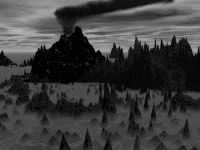by The Reverend Liberator (Ordained Minister of the ULC) [Revised May 30th, 2004]
Introduction
Humankind, able to perceive and consequently driven to understand events in the Universe, creates theoretical models to do so. Some of these models are observation/logic-based and some are not. The rational theories can be studied to great depths elsewhere. This page will address the connection between Hell, religion and vampires.
| “When myths lose their intended benefits, those myths must be replaced by better ones, as has happened and will continue to happen throughout human history.” |
Hell n: the nether realm of the devil and the demons in which the damned suffer everlasting punishment.
religion n: the service or worship of God or the supernatural.
vampires n: the body of a dead person believed to come from the grave at night and suck the blood of persons asleep.
Religion
Religious indoctrination usually begins at an early age. The attempt is to provide a framework to answer life's riddles by using stories that have gained acceptance through tradition. Passed on, generation by generation, the stories change slightly. New religions are born through ashes of the old, but some facets remain constant: 1) the battle of good vs. evil, 2) larger than life characters who overcome great obstacles and 3) stories involving mystical/supernatural environments. The mythological characters and places are created to explain horrific events and become the backdrop for the battle between good and evil. The three ultimately require each other.Religion exists in every culture to answer questions and help its peoples be moral beings. Yet, religious tradition utilizes fantastical creatures and events, ironically scaring its believers into doing the right thing. Since very little of religion rests on observation or logic, truth is never really the ultimate goal. Instead, feeling good, as opposed to the discovery of facts, is one desired end. Another more practical end is the lesson of right and wrong behavior.
Faith itself, the heart of every religion, is based upon believing in that which cannot be perceived. It fuels the need for itself. When people are unable to separate fiction from reality, religion perpetuates itself. That is how myths spread and the institution of religion breeds.
Hell
Throughout the ages, religion has used a powerful weapon to maintain a chokehold on its believers and attack its skeptics: the fear of Hell. The invention of Hell has done very well. It has been used to manipulate people into maintaining ones faith even though it may do very little to mold behavior outside of pleasant conversation or philosophical discussion.The fear of eternal damnation is very real to people despite the fact there is absolutely no concrete proof of its existence. Once again, the line between reality and fantasy has been purposefully blurred. Hell is less real than the television Town of Mayberry except Hell's imaginary ruler must be an extremely bizarre incarnation of Ernest T. Bass.
The faithful are led to believe an actual spiritual war is going on right now. Beautiful angels are at constant odds with cunning devils, demons and creatures too horrible to imagine. God and his white-feathered friends on one side are battling Satan and his leather-skinned devils on the other side. Agnostics are still waiting for a clip of these battles to be aired on CNN.
Vampires
The first vampire was actually a real person, Vlad III Dracula, called the Impaler (1431-1476) 2. He ruled his kingdom relentlessly. He used violence combined with superstition to place fear in his enemies' hearts. His favorite and most gruesome tactics involved placing decapitated heads on posts and impaling dull spears slowly through bodies.A list of his other methods of torture included: nails in heads, cutting off of limbs, blinding, strangulation, burning, cutting off of noses and ears, mutilation of sexual organs, scalping, skinning, exposure to the elements or to wild animals and boiling alive. It's no wonder why the word Dracula imparts ghoulish horrors. Now the word means son of the devil.
Even though it has been said that Dracula was well known for his insistence on truth, Bram Stoker created the vampire myth out of the Dracul history. It may have had to do with Dracula renouncing the Orthodox faith and adopting Catholicism when he was incarcerated for twelve years beginning in 1462. It certainly had something to do with Dracula's ability to be vicious.
Stoker captured a story that is known and enjoyed by people worldwide to this day. Yet his blood-sucking creatures have evolved much like other myths through history. They eventually went from hideous monsters, to blood sucking creatures, to entities with fantastical powers, as they are known today.
The Intersection
A major drawback from the strict and absolute belief in the mass delusion called religion is that modern society has a difficult time coping with the pressures of living. Through a demand for scientific advancement and technological comfort, knowledge of logic, mathematics and areas of science is crucial for survival. The contrast between the ephemeral religion of youth and the practical science of adulthood is too difficult a bridge for many to successfully cross.People want to find reason in religion and also get a feeling for the fact-based technological world. Since these needs are not addressed nor are they even recognized, members of modern society seem to gravitate entirely and dangerously to either religion or science, as if the two were separate entities.
The duality of science and religion acts itself out today on the silver screen. An imaginative eye might see that vampirism is the human condition in our technological world. The vampiric foe is the fight against mortal frailty, a struggle to understand nature's seemingly malicious events, and a desire to explore the pleasures of life, namely sensuality.
History indicates nothing unusual about this phenomenon. Every culture has had its own myth which it used to deal with reality. Pantheons were led by gods going by the names Amaterasu Omikami, Anu, Dagda, Enlil, Indra, Odin, Quetzalcoatl, Ra, Shang-Ti, and Zeus. Stories of heroes like King Arthur, Cu Chulainn, Hercules, Hiawatha, Gilgamesh, Vainamoinen, and Yamamoto Date in some cases continue to be used to teach people about character. 3
According to Joseph Campbell, he did not believe that the hero tales found in myths were always there to discover meaning. He once said:
People say that what we're all seeking is a meaning for life. I don't think that's what we're really seeking. I think that what we're seeking is an experience of being alive, so that our life experiences on the purely physical plane will have resonances within our own innermost being and reality, so that we actually feel the rapture of being alive. 4
Nevertheless, while it is true that myths are used to deal with reality, it is also true that reality is in turn molded by the choice of myths used. Myths define moral codes. Sometimes those codes are either unique or valued more or less by certain cultures.
Those who study and learn about a single religion (mythology) may not gain the necessary larger perspective, which would be quite useful in dealing with the problems of a multi-cultural, global community. If an understanding of all people, cultures, and thoughts were desired, then exposing oneself to those views would certainly help.
Conclusion
Myths can prove to be interesting, even helpful and certainly have great value. They exist as models to help us cope and deal with everyday life. However, the models do not perfectly define reality. They are tools for understanding not to be taken literally.Myths are similar to scientific theories in that respect. For instance, the atomic theory of electrons, protons, and neutrons is very useful for explaining many events. Yet, this theory is not useful for every physical circumstance, especially at the quantum level. Even Newton's theories are only useful for large scale phenomenon.
Every theory has its place and its function. They are all limited to some degree however useful they may be. Keep these things in mind as current myths are examined and possibly used. When myths lose their intended benefits (by not helping people understand the value of community, character building, and the giving of one's life to something bigger than oneself) those myths must be replaced by better ones, as has happened and will continue to happen throughout human history.
Footnotes
1 Webster's New Collegiate Dictionary, Copyright 1981 by G & C Merriam Co
2 Dracula's history was taken from http://www.eskimo.com/~mwirkk/vladhist.html and http://www.geocities.com/Athens/Aegean/7545/Dracula.html.
3 Deities and Demigods by James M. Ward with Robert J. Kuntz, Copyright 1980 TSR Games.
4 The Power of Myth by Joseph Campbell, p5, Copyright 1988 Apostrophe S Productions, Inc., Published by Doubleday.
Click here to return to The Cerebral-Cathedral: liberator.net.